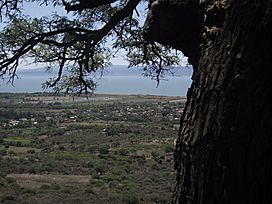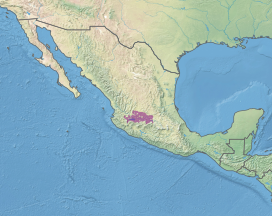Bajío dry forests facts for kids
Quick facts for kids Bajío dry forests |
|
|---|---|

|
|

location of the Bajio dry forests ecoregion in western−central Mexico.
|
|
| Ecology | |
| Realm | Neotropical |
| Biome | tropical and subtropical dry broadleaf forests |
| Borders |
List
|
| Geography | |
| Area | 37,384 km2 (14,434 sq mi) |
| Country | Mexico |
| States | Jalisco, Guanajuato, and Michoacan |
| Conservation | |
| Conservation status | Critical/endangered |
| Global 200 | Mexican dry forests |
| Protected | 7.52% |
The Bajío dry forests is a special type of forest found in western-central Mexico. These forests are called "dry" because they don't get a lot of rain, especially during certain times of the year. They are home to many unique plants and animals.
Contents
Where are the Bajío Dry Forests?
The Bajío dry forests are located in the southwestern part of the Mexican Plateau. This plateau is a large, high area of land in Mexico.
Surrounding Areas
- To the southeast, south, and southwest, the dry forests are next to the Trans-Mexican Volcanic Belt pine-oak forests. These forests are found in the mountains and volcanoes of the Trans-Mexican Volcanic Belt, which forms the southern edge of the Mexican Plateau.
- To the northwest, the Sierra Madre Occidental pine-oak forests of the Sierra Madre Occidental mountain range border the ecoregion.
Unique Mountain "Islands"
Many mountains rise up from the plateau within the dry forests. These mountains have their own special areas of pine and oak trees, which are sometimes called "sky islands." They are like small islands of a different type of forest, surrounded by the dry forests below.
Transition to Drier Lands
North of the Bajío dry forests, the land becomes drier and cooler. This area is known as the Central Mexican matorral.
Rivers and Lakes
Most of the Bajío dry forests are located in the area drained by the Lerma River. The dry forests also spread around Lake Chapala, which is a large lake at the eastern end of the region. They also reach into the basins of Lake Cuitzeo and Lake Pátzcuaro in the south. These lakes are in "endorheic basins," which means water flows into them but doesn't flow out to the ocean.
Major Cities in the Region
Several important cities are found within the Bajío dry forests ecoregion. These include Guadalajara, Morelia, and Querétaro.
Animals of the Bajío Dry Forests
The Bajío dry forests are home to many interesting animals.
Mammals
Some of the native mammals you might find here include:
- The Mexican wolf (Canus lupus baileyi)
- The pocketed free-tailed bat (Nyctinomops femorosaccus)
Birds
Many different bird species live in these forests, such as:
- The black-throated magpie-jay (Calocitta colliei)
- The thick-billed kingbird (Tyrannus crassirostris)
- The whiskered screech owl (Otus trichopsus)
- The orange-fronted parakeet (Aratinga caniculanis)
- The dwarf vireo (Vireo nelsoni)
- The black-polled yellowthroat (Geothlypis speciosa)
How People Have Changed the Forests
The Bajío dry forests ecoregion has a lot of people living in it. Over many hundreds of years, people have used the land for different things. This has caused the original dry forests to shrink into smaller areas.
Changes in Plant Life
In the past, tall, dry deciduous forests were the main type of plant life. These are forests where trees lose their leaves during the dry season. Now, you are more likely to see thorn scrub and subtropical matorral. These are areas with smaller, tougher plants, often with thorns. There are also many farms and pastures for animals where the forests used to be.
Protecting the Bajío Dry Forests
About 7.52% of the Bajío dry forests ecoregion is now protected. This means these areas are set aside to help keep the plants and animals safe.
Examples of Protected Areas
Some of the protected areas in this ecoregion include:
- Cerro de Las Campanas National Park
- El Cimatario National Park
- Lago de Camécuaro National Park
- La Primavera Flora and Fauna Protection Area
- Siete Luminarias Natural Monument
- Sierra del Águila Protected Area
See also
 In Spanish: Bosques secos del Bajío para niños
In Spanish: Bosques secos del Bajío para niños
- List of ecoregions in Mexico

